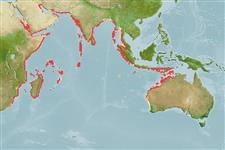>
Mulliformes (Goatfishes) >
Mullidae (Goatfishes)
Etymology: Upeneus: Greek, ypene, -es = upper lip (Ref. 45335); margarethae: Named for Margaretha Uiblein (née Feichtinger)..
Environment: milieu / climate zone / depth range / distribution range
Ekologi
laut berasosiasi dengan karang; kisaran kedalaman 8 - 50 m (Ref. 83903). Tropical
Indian Ocean: Red Sea to Somalia, Kenya, Mozambique, Madagascar, Persian Gulf, Sri Lanka, NW Australia, N Australia (Arafura Sea).
Size / Weight / umur
Maturity: Lm ? range ? - ? cm
Max length : 11.0 cm SL jantan/; (Ref. 83903)
deskripsi pendek
Kunci identifiaksi (pengenalan) | Morfologi | Morfometrik
Duri punggung (Keseluruhan (total)) : 8; duri punggung lunak (Keseluruhan (total)) : 9. This species is distinguished by the following characters: D VIII,9; pectoral fins 13-14, usually 14 (in 26 of 29 individuals); gill rakers 4-7 + 16-18 = 21-24; lateral line scales 28-30; body depth at first dorsal fin origin 22-26% SL and at anus 20-24% SL; caudal-peduncle depth 9.3-11% SL; maximum head depth 19-23% SL; head depth through eye 15-19% SL; head length 27-31%SL; orbit length 6.5-9.1% SL; upper jaw length 10-12% SL; barbel length 16-20% SL; caudal-fin length 27-31% SL; anal-fin height 14-18% SL; pelvic-fin length 20-24% SL; pectoral-fin length 21-25% SL; first dorsal-fin height 20-23% SL; second dorsal-fin height 16-20% SL; 8-10 total bars on caudal fin, 4 bars on upper caudal-fin lobe, 3 on lobe itself and 1 at the lobe base; broad red band lower caudal-fin lobe, covering up to 5-6 red bars which are only partly visible along the outer, ventral fin margin in fresh fish, usually not retained on preserved one, but with some traces of bars and dark pigmentation at the lower lobe fin tip; a mid-lateral body stripe running through eye, red from snout tip to eye and yellow from behind eye to caudal-fin base, not retained on preserved fish; tip of first dorsal-fin pale; barbels white; body red above lateral line, body and head white laterally, with red or rose dots or blotches, ventral side of head and belly white; body uniformly pale brown in preserved fish; first minute dorsal-fin spine often dark pigmented forming a small spot at fin origin that is often distinct from above in preserved fish (Ref. 83903).
Life cycle and mating behavior
Maturities | Reproduksi, perkembang biakan | Spawnings | Egg(s) | Fecundities | Larva
Uiblein, F. and P.C. Heemstra, 2010. A taxonomic review of the Western Indian Ocean goatfishes of the genus Upeneus (Family Mullidae), with descriptions of four new species. Smithiana 11:35-71. (Ref. 83903)
Status IUCN Red List (Ref. 130435)
ancaman kepada manusia
Harmless
penggunaan manusia
Alat, peralatan
laporan khas
muat turun XML
Sumber internet
Estimates based on models
Preferred temperature (Ref.
123201): 24.1 - 29.3, mean 27.3 °C (based on 274 cells).
Phylogenetic diversity index (Ref.
82804): PD
50 = 0.5000 [Uniqueness, from 0.5 = low to 2.0 = high].
Bayesian length-weight: a=0.00955 (0.00454 - 0.02011), b=3.10 (2.93 - 3.27), in cm total length, based on LWR estimates for this Genus-body shape (Ref.
93245).
Trophic level (Ref.
69278): 3.4 ±0.4 se; based on size and trophs of closest relatives
Daya lenting (Ref.
120179): Tinggi, Waktu penggandaan populasi minimum kurang dari 15 bulan (Preliminary K or Fecundity.).
Fishing Vulnerability (Ref.
59153): Low vulnerability (10 of 100).
